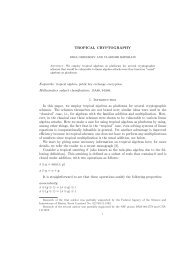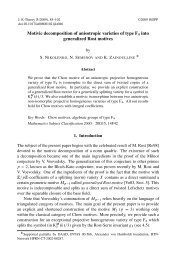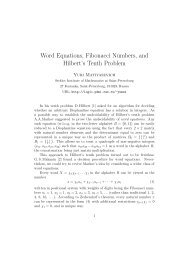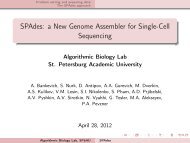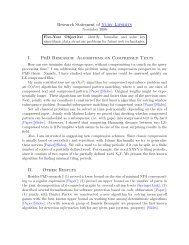SPAdes - Laboratory of Mathematical Logic
SPAdes - Laboratory of Mathematical Logic
SPAdes - Laboratory of Mathematical Logic
Create successful ePaper yourself
Turn your PDF publications into a flip-book with our unique Google optimized e-Paper software.
Problem setting and preparing data<br />
The <strong>SPAdes</strong> approach<br />
<strong>SPAdes</strong>: a New Genome Assembler<br />
for Single-Cell Sequencing<br />
Algorithmic Biology Lab<br />
St. Petersburg Academic University<br />
A. Bankevich, S. Nurk, D. Antipov, A.A. Gurevich, M. Dvorkin,<br />
A. Korobeynikov, A.S. Kulikov, V.M. Lesin, S.I. Nikolenko, S. Pham,<br />
A.D. Prjibelski, A.V. Pyshkin, A.V. Sirotkin, N. Vyahhi, G. Tesler,<br />
M.A. Alekseyev, P.A. Pevzner<br />
August 27, 2012<br />
Algorithmic Biology Lab, SPbAU <strong>SPAdes</strong>
Outline<br />
Problem setting and preparing data<br />
The <strong>SPAdes</strong> approach<br />
1 Problem setting and preparing data<br />
Assembly: problem and pipeline<br />
Error correction: BayesHammer<br />
Assembly: problem and pipeline<br />
Error correction: BayesHammer<br />
2 The <strong>SPAdes</strong> approach<br />
De Bruijn graphs, mate-pairs, and simplification<br />
Paired de Bruijn graphs and repeats<br />
Algorithmic Biology Lab, SPbAU <strong>SPAdes</strong>
Problem setting and preparing data<br />
The <strong>SPAdes</strong> approach<br />
Single-cell sequencing<br />
Assembly: problem and pipeline<br />
Error correction: BayesHammer<br />
Recent years have seen the advent <strong>of</strong> single-cell sequencing as<br />
a way to sequence genomes that we previously couldn’t.<br />
It turns out that many bacteria (“dark matter <strong>of</strong> life”) cannot<br />
be sequenced by standard techniques, most <strong>of</strong>ten because they<br />
cannot be cloned millions <strong>of</strong> times to get large DNA samples<br />
needed for regular sequencing.<br />
This is usually due to the fact that these bacteria come in<br />
metagenomic samples (ocean samples, microbiomes <strong>of</strong> larger<br />
organisms etc.) and cannot be cultivated alone.<br />
For now, metagenomic analysis can yield more or less only<br />
individual genes.<br />
Single-cell sequencing can get reasonable sequencing coverage<br />
by amplifying a single cell (more on that later).<br />
Algorithmic Biology Lab, SPbAU <strong>SPAdes</strong>
Problem setting and preparing data<br />
The <strong>SPAdes</strong> approach<br />
Single-cell sequencing<br />
Important examples:<br />
Assembly: problem and pipeline<br />
Error correction: BayesHammer<br />
[Woyke et al., 2009, 2010]: marine cells sequencing from<br />
metagenomic ocean samples;<br />
[Dalerba et al., 2011]: studying tumor heterogeneity;<br />
[Islam et al., 2011]: characterizing single cell transcriptome;<br />
[Xu et al., 2012; Hou et al., 2012]: single-cell sequencing <strong>of</strong><br />
tumor cells;<br />
[Yoon et al., 2011]: sequencing bacteria from the human<br />
microbiome;<br />
[Chitsaz et al., 2011]: assembling single-cell sequencing data<br />
from marine samples.<br />
So how does single-cell sequencing work and why do we need<br />
new assemblers for it?<br />
Algorithmic Biology Lab, SPbAU <strong>SPAdes</strong>
Problem setting and preparing data<br />
The <strong>SPAdes</strong> approach<br />
The assembly problem<br />
Assembly: problem and pipeline<br />
Error correction: BayesHammer<br />
First, let us go back to the general assembly problem.<br />
We have a long DNA sequence but cannot read it directly.<br />
Instead, we can perform sequencing, getting many random<br />
small pieces <strong>of</strong> the DNA (reads).<br />
For popular sequencing technologies, reads are usually<br />
L ≈ 35-400bp long.<br />
The assembly problem is to reconstruct the original sequence<br />
from the set <strong>of</strong> reads.<br />
Algorithmic Biology Lab, SPbAU <strong>SPAdes</strong>
Problem setting and preparing data<br />
The <strong>SPAdes</strong> approach<br />
The assembly problem<br />
Assembly: problem and pipeline<br />
Error correction: BayesHammer<br />
In many sequencing methods, we read ≈ L nucleotides from<br />
both ends <strong>of</strong> a longer DNA fragment.<br />
This leads to paired-end reads (read pairs): two reads for<br />
which we know the distance between them [Chaisson et al.,<br />
2009].<br />
left read<br />
read length read length<br />
gap<br />
distance<br />
insert size<br />
Algorithmic Biology Lab, SPbAU <strong>SPAdes</strong><br />
genome<br />
right read
MDA technology<br />
Problem setting and preparing data<br />
The <strong>SPAdes</strong> approach<br />
Assembly: problem and pipeline<br />
Error correction: BayesHammer<br />
Recent single-cell sequencing projects use the MDA technology<br />
[Dean et al., 2001; 2002]:<br />
Algorithmic Biology Lab, SPbAU <strong>SPAdes</strong>
MDA technology<br />
Problem setting and preparing data<br />
The <strong>SPAdes</strong> approach<br />
Assembly: problem and pipeline<br />
Error correction: BayesHammer<br />
However, MDA has a number <strong>of</strong> problems that seriously<br />
complicate assembly.<br />
First and foremost, non-uniform coverage:<br />
Algorithmic Biology Lab, SPbAU <strong>SPAdes</strong>
MDA technology<br />
Problem setting and preparing data<br />
The <strong>SPAdes</strong> approach<br />
Assembly: problem and pipeline<br />
Error correction: BayesHammer<br />
This means that a coverage threshold (<strong>of</strong>ten used in<br />
conventional assemblers) would throw a lot <strong>of</strong> the genome<br />
away:<br />
Algorithmic Biology Lab, SPbAU <strong>SPAdes</strong>
MDA technology<br />
Problem setting and preparing data<br />
The <strong>SPAdes</strong> approach<br />
Assembly: problem and pipeline<br />
Error correction: BayesHammer<br />
The insert size distribution is also not nearly as nice:<br />
Finally, there are simply more errors, including lots <strong>of</strong> chimeric<br />
connections.<br />
Algorithmic Biology Lab, SPbAU <strong>SPAdes</strong>
MDA technology<br />
Problem setting and preparing data<br />
The <strong>SPAdes</strong> approach<br />
Computational problems <strong>of</strong> MDA:<br />
Assembly: problem and pipeline<br />
Error correction: BayesHammer<br />
1 highly non-uniform coverage;<br />
2 noisier, more complicated insert size distribution;<br />
3 more chimeric connections (sometimes with large coverage);<br />
4 more frequent errors.<br />
First single-cell assembler: E+V-SC (Euler+Velvet-Single-Cell<br />
assembler) [Chitsaz et al., 2011]; captured 25% more genes<br />
than “regular” assemblers on single-cell data.<br />
Meet <strong>SPAdes</strong> – a new assembler specifically designed for the<br />
single-cell case.<br />
Algorithmic Biology Lab, SPbAU <strong>SPAdes</strong>
Assembly pipeline<br />
Problem setting and preparing data<br />
The <strong>SPAdes</strong> approach<br />
Algorithmic Biology Lab, SPbAU <strong>SPAdes</strong><br />
Assembly: problem and pipeline<br />
Error correction: BayesHammer
BayesHammer<br />
Problem setting and preparing data<br />
The <strong>SPAdes</strong> approach<br />
Assembly: problem and pipeline<br />
Error correction: BayesHammer<br />
Basic idea: break reads into k-mers and study the set <strong>of</strong><br />
k-mers.<br />
ACGTGTGATGCATGATCG<br />
ACGTGTGATGC<br />
CGTGTGATGCA<br />
GTGTGATGCAT<br />
TGTGATGCATG<br />
GTGATGCATGA<br />
TGATGCATGAT<br />
GATGCATGATC<br />
ATGCATGATCG<br />
k-mers are the basic building block in modern assemblers (de<br />
Bruijn graph). However, de Bruijn graphs are not directly<br />
applicable because <strong>of</strong> errors in reads.<br />
Algorithmic Biology Lab, SPbAU <strong>SPAdes</strong>
BayesHammer<br />
Problem setting and preparing data<br />
The <strong>SPAdes</strong> approach<br />
Assembly: problem and pipeline<br />
Error correction: BayesHammer<br />
The first step in assembly is to fix as many errors as we can.<br />
If we know what k-mers are correct and how to correct others,<br />
it’s easy to correct reads.<br />
solid k-mers<br />
original read<br />
ACGTGTGATGCATGATCG<br />
ACGTGTGATGC<br />
correction<br />
CGTGTGATGCA<br />
GTGTGATGCAT<br />
TGTGATGCATG<br />
GTGATGCATGA<br />
TGATGCATGAT<br />
GATGCATGATC<br />
ATGCATGATCG<br />
correction<br />
correction<br />
Algorithmic Biology Lab, SPbAU <strong>SPAdes</strong><br />
ACGTGTGATGCATGATCG<br />
ACGTGTGATGC<br />
CGTGAGATGCA<br />
GTGAGATGCAT<br />
TGTGATGCATG<br />
GTGATGCATGA<br />
AGATGCATGAT<br />
GATGCATGATC<br />
ATGCATGATCG<br />
ACGTGAGATGCATGATCG<br />
corrected read
BayesHammer<br />
Problem setting and preparing data<br />
The <strong>SPAdes</strong> approach<br />
Assembly: problem and pipeline<br />
Error correction: BayesHammer<br />
In regular (multi-cell) error correction, we can look at how<br />
many copies <strong>of</strong> a k-mer there are and assume that rare k-mers<br />
represent errors.<br />
In single-cell datasets, this idea fails due to non-uniform<br />
coverage.<br />
10 4<br />
10 2<br />
10 0<br />
0 1,000 2,000 3,000 4,000<br />
KBases<br />
Algorithmic Biology Lab, SPbAU <strong>SPAdes</strong>
BayesHammer<br />
Problem setting and preparing data<br />
The <strong>SPAdes</strong> approach<br />
Assembly: problem and pipeline<br />
Error correction: BayesHammer<br />
Basic idea: a k-mer is covered many times (even if<br />
non-uniformly).<br />
Thus, if we look at the set <strong>of</strong> similar k-mers we can find out<br />
what to do because nucleotides <strong>of</strong> the central k-mer will be<br />
better covered than others.<br />
Problem: there may be several centers in such a cluster.<br />
ATGTGTGATGC<br />
ACGTGGGATGC<br />
ACGTGTGATGC<br />
ACGTGTGATGC<br />
ATGTGTGATGC<br />
ACGTGAGATGC<br />
ACGTGTGATGC<br />
Algorithmic Biology Lab, SPbAU <strong>SPAdes</strong><br />
ATGTGGGATGC<br />
ACGTGGGATGC<br />
ACGTGGGATGC<br />
ACGTGTGATGC<br />
ATGTGTGATGC<br />
ACGTGTGATAC<br />
ACGTGTGATGC<br />
ACGTGGGATGC
BayesHammer<br />
Problem setting and preparing data<br />
The <strong>SPAdes</strong> approach<br />
Assembly: problem and pipeline<br />
Error correction: BayesHammer<br />
In Hammer, Medvedev et al. (2011) constructed and roughly<br />
clustered the Hamming graph <strong>of</strong> k-mers; BayesHammer uses<br />
probabilistic subclustering to get multiple centers in a cluster.<br />
Reads<br />
ACGTGTG<br />
ACATGTG<br />
ACCTGTC<br />
k-mers<br />
ACGTG<br />
CGTGT<br />
GTGTG<br />
ACATG<br />
CATGT<br />
ATGTG<br />
ACCTG<br />
CCTGT<br />
CTGTC<br />
ACATG<br />
Hamming graph<br />
ACCTG<br />
ACGTG CGTGT<br />
GTGTG<br />
ATGTG<br />
CTGTC<br />
CATGT<br />
CCTGT<br />
As a result, BayesHammer corrects single-cell datasets much<br />
better than other tools.<br />
Algorithmic Biology Lab, SPbAU <strong>SPAdes</strong>
Outline<br />
Problem setting and preparing data<br />
The <strong>SPAdes</strong> approach<br />
1 Problem setting and preparing data<br />
Assembly: problem and pipeline<br />
Error correction: BayesHammer<br />
De Bruijn graphs, mate-pairs, and simplification<br />
Paired de Bruijn graphs and repeats<br />
2 The <strong>SPAdes</strong> approach<br />
De Bruijn graphs, mate-pairs, and simplification<br />
Paired de Bruijn graphs and repeats<br />
Algorithmic Biology Lab, SPbAU <strong>SPAdes</strong>
De Bruijn graphs<br />
Problem setting and preparing data<br />
The <strong>SPAdes</strong> approach<br />
De Bruijn graphs, mate-pairs, and simplification<br />
Paired de Bruijn graphs and repeats<br />
When there are relatively few k-mers left, we can begin global<br />
processing (the actual assembly).<br />
Basic idea: de Bruijn graph [Idury & Waterman, 1995; Pevzner<br />
et al., 2001].<br />
Algorithmic Biology Lab, SPbAU <strong>SPAdes</strong>
De Bruijn graphs<br />
Problem setting and preparing data<br />
The <strong>SPAdes</strong> approach<br />
Algorithmic Biology Lab, SPbAU <strong>SPAdes</strong><br />
De Bruijn graphs, mate-pairs, and simplification<br />
Paired de Bruijn graphs and repeats
De Bruijn graphs<br />
Problem setting and preparing data<br />
The <strong>SPAdes</strong> approach<br />
Algorithmic Biology Lab, SPbAU <strong>SPAdes</strong><br />
De Bruijn graphs, mate-pairs, and simplification<br />
Paired de Bruijn graphs and repeats
De Bruijn graphs<br />
Problem setting and preparing data<br />
The <strong>SPAdes</strong> approach<br />
Algorithmic Biology Lab, SPbAU <strong>SPAdes</strong><br />
De Bruijn graphs, mate-pairs, and simplification<br />
Paired de Bruijn graphs and repeats
De Bruijn graphs<br />
Problem setting and preparing data<br />
The <strong>SPAdes</strong> approach<br />
Algorithmic Biology Lab, SPbAU <strong>SPAdes</strong><br />
De Bruijn graphs, mate-pairs, and simplification<br />
Paired de Bruijn graphs and repeats
De Bruijn graphs<br />
Problem setting and preparing data<br />
The <strong>SPAdes</strong> approach<br />
Algorithmic Biology Lab, SPbAU <strong>SPAdes</strong><br />
De Bruijn graphs, mate-pairs, and simplification<br />
Paired de Bruijn graphs and repeats
Problem setting and preparing data<br />
The <strong>SPAdes</strong> approach<br />
De Bruijn graph and errors<br />
De Bruijn graphs, mate-pairs, and simplification<br />
Paired de Bruijn graphs and repeats<br />
Now, if there is a single string uniting all k-mers, it<br />
corresponds to an Eulerian cycle/path in this graph.<br />
However, due to sequencing errors and repeats we cannot just<br />
find a Eulerian cycle/path and think that we’re done.<br />
In the presence <strong>of</strong> errors, this is a hard problem, and not very<br />
well defined.<br />
Algorithmic Biology Lab, SPbAU <strong>SPAdes</strong>
Problem setting and preparing data<br />
The <strong>SPAdes</strong> approach<br />
De Bruijn graph before simplification<br />
Algorithmic Biology Lab, SPbAU <strong>SPAdes</strong><br />
De Bruijn graphs, mate-pairs, and simplification<br />
Paired de Bruijn graphs and repeats
Problem setting and preparing data<br />
The <strong>SPAdes</strong> approach<br />
De Bruijn graph simplification: tips<br />
De Bruijn graphs, mate-pairs, and simplification<br />
Paired de Bruijn graphs and repeats<br />
There are three kinds <strong>of</strong> common errors in the de Bruijn graph.<br />
They all have additional complications in the single-cell case.<br />
A tip results from a single error close to the end <strong>of</strong> a read.<br />
<strong>SPAdes</strong> incorporates a tip clipping algorithm that is enhanced<br />
by gap closing (see below).<br />
Algorithmic Biology Lab, SPbAU <strong>SPAdes</strong>
Problem setting and preparing data<br />
The <strong>SPAdes</strong> approach<br />
De Bruijn graph simplification: bulges<br />
De Bruijn graphs, mate-pairs, and simplification<br />
Paired de Bruijn graphs and repeats<br />
There are three kinds <strong>of</strong> common errors in the de Bruijn graph.<br />
They all have additional complications in the single-cell case.<br />
A bulge occurs when the error is in the middle.<br />
<strong>SPAdes</strong> projects bulges with additional bookkeeping to<br />
preserve the original mappings – bulge corremoval.<br />
Algorithmic Biology Lab, SPbAU <strong>SPAdes</strong>
Problem setting and preparing data<br />
The <strong>SPAdes</strong> approach<br />
De Bruijn graph simplification: chimeras<br />
De Bruijn graphs, mate-pairs, and simplification<br />
Paired de Bruijn graphs and repeats<br />
There are three kinds <strong>of</strong> common errors in the de Bruijn graph.<br />
They all have additional complications in the single-cell case.<br />
A chimeric connection joins two unrelated parts <strong>of</strong> the graph.<br />
<strong>SPAdes</strong> uses a novel algorithm for removing chimeric<br />
connections.<br />
Algorithmic Biology Lab, SPbAU <strong>SPAdes</strong>
Problem setting and preparing data<br />
The <strong>SPAdes</strong> approach<br />
De Bruijn graph simplification: scheduling<br />
De Bruijn graphs, mate-pairs, and simplification<br />
Paired de Bruijn graphs and repeats<br />
There are three kinds <strong>of</strong> common errors in the de Bruijn graph.<br />
They all have additional complications in the single-cell case.<br />
And they are all usually superimposed in a single entangled<br />
mess.<br />
<strong>SPAdes</strong> uses special scheduling algorithms to process bulges<br />
and chimerics in an optimal order.<br />
Algorithmic Biology Lab, SPbAU <strong>SPAdes</strong>
Problem setting and preparing data<br />
The <strong>SPAdes</strong> approach<br />
De Bruijn graph simplification<br />
De Bruijn graphs, mate-pairs, and simplification<br />
Paired de Bruijn graphs and repeats<br />
To sum up: for single-cell datasets, errors are harder to correct<br />
because coverage is not a reliable way to recognize an error.<br />
We have developed several new algorithms that process errors<br />
based on graph structure rather than coverage alone.<br />
Besides, <strong>SPAdes</strong> corrects errors iteratively, in an order resulting<br />
from special scheduling policies.<br />
Algorithmic Biology Lab, SPbAU <strong>SPAdes</strong>
Problem setting and preparing data<br />
The <strong>SPAdes</strong> approach<br />
Multisized de Bruijn graphs<br />
De Bruijn graphs, mate-pairs, and simplification<br />
Paired de Bruijn graphs and repeats<br />
Let us now think about the value <strong>of</strong> k. How does the graph<br />
change if k changes?<br />
For a small k, the graph is well-connected but very entangled.<br />
Algorithmic Biology Lab, SPbAU <strong>SPAdes</strong>
Problem setting and preparing data<br />
The <strong>SPAdes</strong> approach<br />
Multisized de Bruijn graphs<br />
De Bruijn graphs, mate-pairs, and simplification<br />
Paired de Bruijn graphs and repeats<br />
Let us now think about the value <strong>of</strong> k. How does the graph<br />
change if k changes?<br />
For a large k, the graph is less entangled but may become<br />
disconnected.<br />
Algorithmic Biology Lab, SPbAU <strong>SPAdes</strong>
Problem setting and preparing data<br />
The <strong>SPAdes</strong> approach<br />
Multisized de Bruijn graphs<br />
De Bruijn graphs, mate-pairs, and simplification<br />
Paired de Bruijn graphs and repeats<br />
Let us now think about the value <strong>of</strong> k. How does the graph<br />
change if k changes?<br />
<strong>SPAdes</strong> combines several different values <strong>of</strong> k to get the best<br />
<strong>of</strong> all worlds (see also IDBA [Peng et al., 2010]).<br />
Algorithmic Biology Lab, SPbAU <strong>SPAdes</strong>
Repeats<br />
Problem setting and preparing data<br />
The <strong>SPAdes</strong> approach<br />
De Bruijn graphs, mate-pairs, and simplification<br />
Paired de Bruijn graphs and repeats<br />
A repeat in the genome results in a path with multiple<br />
entrances and/or multiple exits. Sometimes they can be<br />
resolved with long reads; sometimes not, and they become<br />
tangles.<br />
This repeat is easy to handle.<br />
Algorithmic Biology Lab, SPbAU <strong>SPAdes</strong>
Repeats<br />
Problem setting and preparing data<br />
The <strong>SPAdes</strong> approach<br />
De Bruijn graphs, mate-pairs, and simplification<br />
Paired de Bruijn graphs and repeats<br />
A repeat in the genome results in a path with multiple<br />
entrances and/or multiple exits. Sometimes they can be<br />
resolved with long reads; sometimes not, and they become<br />
tangles.<br />
This one is not.<br />
Algorithmic Biology Lab, SPbAU <strong>SPAdes</strong>
Problem setting and preparing data<br />
The <strong>SPAdes</strong> approach<br />
Paired reads and paired de Bruijn graphs<br />
Recall that reads come in pairs.<br />
De Bruijn graphs, mate-pairs, and simplification<br />
Paired de Bruijn graphs and repeats<br />
We could construct a paired de Bruijn graph in which vertices<br />
correspond to pairs <strong>of</strong> k-mers (Medvedev et al., 2011). This<br />
graph is much sparser than a regular de Bruijn graph.<br />
Algorithmic Biology Lab, SPbAU <strong>SPAdes</strong>
Problem setting and preparing data<br />
The <strong>SPAdes</strong> approach<br />
Paired reads and paired de Bruijn graphs<br />
Algorithmic Biology Lab, SPbAU <strong>SPAdes</strong><br />
De Bruijn graphs, mate-pairs, and simplification<br />
Paired de Bruijn graphs and repeats
Problem setting and preparing data<br />
The <strong>SPAdes</strong> approach<br />
Paired reads and paired de Bruijn graphs<br />
Algorithmic Biology Lab, SPbAU <strong>SPAdes</strong><br />
De Bruijn graphs, mate-pairs, and simplification<br />
Paired de Bruijn graphs and repeats
Problem setting and preparing data<br />
The <strong>SPAdes</strong> approach<br />
Paired reads and paired de Bruijn graphs<br />
Algorithmic Biology Lab, SPbAU <strong>SPAdes</strong><br />
De Bruijn graphs, mate-pairs, and simplification<br />
Paired de Bruijn graphs and repeats
Problem setting and preparing data<br />
The <strong>SPAdes</strong> approach<br />
Paired reads and paired de Bruijn graphs<br />
Algorithmic Biology Lab, SPbAU <strong>SPAdes</strong><br />
De Bruijn graphs, mate-pairs, and simplification<br />
Paired de Bruijn graphs and repeats
Problem setting and preparing data<br />
The <strong>SPAdes</strong> approach<br />
Paired DBG in <strong>SPAdes</strong><br />
De Bruijn graphs, mate-pairs, and simplification<br />
Paired de Bruijn graphs and repeats<br />
Repeat resolution in <strong>SPAdes</strong> stems from the basic idea <strong>of</strong> a<br />
paired de Bruijn graph (with a few extra strategies).<br />
In theory, there’s no difference between theory and practice; in<br />
practice, there is: the distance between paired reads is not<br />
known exactly.<br />
This is a major problem for implementing paired de Bruijn<br />
graphs.<br />
Algorithmic Biology Lab, SPbAU <strong>SPAdes</strong>
Problem setting and preparing data<br />
The <strong>SPAdes</strong> approach<br />
Paired DBG in <strong>SPAdes</strong><br />
De Bruijn graphs, mate-pairs, and simplification<br />
Paired de Bruijn graphs and repeats<br />
<strong>SPAdes</strong> approach to distance estimation: choose distances<br />
(from a finite set given by graph structure) by clustering<br />
existing paired info.<br />
Algorithmic Biology Lab, SPbAU <strong>SPAdes</strong>
Closing gaps<br />
Problem setting and preparing data<br />
The <strong>SPAdes</strong> approach<br />
De Bruijn graphs, mate-pairs, and simplification<br />
Paired de Bruijn graphs and repeats<br />
Gaps in coverage lead to discontinuities in the de Bruijn graph.<br />
Sometimes, gaps can be closed if matching paired info is<br />
available.<br />
gap closing<br />
with read pairs ...TCGATCGACGTGTGATGC<br />
TGCATGATCGAATGTAT...<br />
CGTGTG ATCGAA<br />
ACGTGT GATCGA<br />
GACGTG TGATCG<br />
<strong>SPAdes</strong> closes gaps not only during scaffolding, but also before<br />
tip clipping.<br />
Algorithmic Biology Lab, SPbAU <strong>SPAdes</strong>
Problem setting and preparing data<br />
The <strong>SPAdes</strong> approach<br />
De Bruijn graph before simplification<br />
Algorithmic Biology Lab, SPbAU <strong>SPAdes</strong><br />
De Bruijn graphs, mate-pairs, and simplification<br />
Paired de Bruijn graphs and repeats
Problem setting and preparing data<br />
The <strong>SPAdes</strong> approach<br />
De Bruijn graph after simplification<br />
Algorithmic Biology Lab, SPbAU <strong>SPAdes</strong><br />
De Bruijn graphs, mate-pairs, and simplification<br />
Paired de Bruijn graphs and repeats
Rectangles<br />
Problem setting and preparing data<br />
The <strong>SPAdes</strong> approach<br />
Algorithmic Biology Lab, SPbAU <strong>SPAdes</strong><br />
De Bruijn graphs, mate-pairs, and simplification<br />
Paired de Bruijn graphs and repeats<br />
A recent development<br />
[Vyahhi et al., 2012]<br />
introduces rectangle graphs<br />
as a way to formalize paired<br />
de Bruijn graphs with<br />
uncertain distances.<br />
A rectangle represents a pair<br />
<strong>of</strong> edges on estimated<br />
distance D in the de Bruijn<br />
graph; the blue edge goes<br />
through the corresponding<br />
k-mers.
Rectangles<br />
Problem setting and preparing data<br />
The <strong>SPAdes</strong> approach<br />
De Bruijn graphs, mate-pairs, and simplification<br />
Paired de Bruijn graphs and repeats<br />
The problem is to find a path in the rectangle graph:<br />
Algorithmic Biology Lab, SPbAU <strong>SPAdes</strong>
Rectangles<br />
Problem setting and preparing data<br />
The <strong>SPAdes</strong> approach<br />
Algorithmic Biology Lab, SPbAU <strong>SPAdes</strong><br />
De Bruijn graphs, mate-pairs, and simplification<br />
Paired de Bruijn graphs and repeats<br />
If the distances are (slightly)<br />
imprecise, it means that we<br />
have to glue more points.<br />
Now insert size analysis<br />
maps to choosing the correct<br />
path through a rectangle –<br />
we can use more global<br />
considerations, use<br />
neighboring rectangles.
Omnigraph<br />
Problem setting and preparing data<br />
The <strong>SPAdes</strong> approach<br />
De Bruijn graphs, mate-pairs, and simplification<br />
Paired de Bruijn graphs and repeats<br />
Note that many <strong>of</strong> these procedures (graph simplification,<br />
repeat resolution) actually do not depend on the underlying<br />
sequence, but only on a few edge parameters (coverage,<br />
length, paired info).<br />
In the code, these operations are abstracted out and made into<br />
general graph algorithms; we call this approach the omnigraph.<br />
Compare with A-Bruijn graph (Pevzner, Tang, Tesler, 2004).<br />
Algorithmic Biology Lab, SPbAU <strong>SPAdes</strong>
Omnigraph<br />
Problem setting and preparing data<br />
The <strong>SPAdes</strong> approach<br />
De Bruijn graphs, mate-pairs, and simplification<br />
Paired de Bruijn graphs and repeats<br />
Thus, <strong>SPAdes</strong> can be used for other similar problems, e.g.<br />
proteome assembly (although no real-life projects have been<br />
completed yet).<br />
In general, assemblers <strong>of</strong>ten make unjustified assumptions; in<br />
the single-cell case, such assumptions are wrong much more<br />
<strong>of</strong>ten.<br />
We have designed SPADES to make more accurate assemblies,<br />
cutting less corners than other assemblers; for single-cell<br />
projects, it is more important than ever.<br />
Algorithmic Biology Lab, SPbAU <strong>SPAdes</strong>
All together now<br />
Problem setting and preparing data<br />
The <strong>SPAdes</strong> approach<br />
Algorithmic Biology Lab, SPbAU <strong>SPAdes</strong><br />
De Bruijn graphs, mate-pairs, and simplification<br />
Paired de Bruijn graphs and repeats
All together now<br />
Problem setting and preparing data<br />
The <strong>SPAdes</strong> approach<br />
Algorithmic Biology Lab, SPbAU <strong>SPAdes</strong><br />
De Bruijn graphs, mate-pairs, and simplification<br />
Paired de Bruijn graphs and repeats
All together now<br />
Problem setting and preparing data<br />
The <strong>SPAdes</strong> approach<br />
Algorithmic Biology Lab, SPbAU <strong>SPAdes</strong><br />
De Bruijn graphs, mate-pairs, and simplification<br />
Paired de Bruijn graphs and repeats
Results<br />
Problem setting and preparing data<br />
The <strong>SPAdes</strong> approach<br />
On single-cell data, <strong>SPAdes</strong> works best:<br />
Algorithmic Biology Lab, SPbAU <strong>SPAdes</strong><br />
De Bruijn graphs, mate-pairs, and simplification<br />
Paired de Bruijn graphs and repeats
Results<br />
Problem setting and preparing data<br />
The <strong>SPAdes</strong> approach<br />
De Bruijn graphs, mate-pairs, and simplification<br />
Paired de Bruijn graphs and repeats<br />
It outperforms “conventional” assemblers even in the multicell case:<br />
Algorithmic Biology Lab, SPbAU <strong>SPAdes</strong>
Results<br />
Problem setting and preparing data<br />
The <strong>SPAdes</strong> approach<br />
Algorithmic Biology Lab, SPbAU <strong>SPAdes</strong><br />
De Bruijn graphs, mate-pairs, and simplification<br />
Paired de Bruijn graphs and repeats
Results<br />
Problem setting and preparing data<br />
The <strong>SPAdes</strong> approach<br />
Algorithmic Biology Lab, SPbAU <strong>SPAdes</strong><br />
De Bruijn graphs, mate-pairs, and simplification<br />
Paired de Bruijn graphs and repeats
Results<br />
Problem setting and preparing data<br />
The <strong>SPAdes</strong> approach<br />
Algorithmic Biology Lab, SPbAU <strong>SPAdes</strong><br />
De Bruijn graphs, mate-pairs, and simplification<br />
Paired de Bruijn graphs and repeats
Results<br />
Problem setting and preparing data<br />
The <strong>SPAdes</strong> approach<br />
Algorithmic Biology Lab, SPbAU <strong>SPAdes</strong><br />
De Bruijn graphs, mate-pairs, and simplification<br />
Paired de Bruijn graphs and repeats
Collaborations<br />
Problem setting and preparing data<br />
The <strong>SPAdes</strong> approach<br />
Collaborations on single-cell projects:<br />
De Bruijn graphs, mate-pairs, and simplification<br />
Paired de Bruijn graphs and repeats<br />
1 J. Craig Venter Institite (capturing “dark matter <strong>of</strong> life”;<br />
sequencing pathogens isolated from hospital environment);<br />
2 Scripps Institution <strong>of</strong> Oceanography (antibiotics producing<br />
bacteria);<br />
3 Scripps Translational Medicine (sequencing and comparative<br />
genomics <strong>of</strong> drug-resistant pathogens);<br />
4 Bigelow Marine <strong>Laboratory</strong> (sequencing marine bacteria).<br />
Algorithmic Biology Lab, SPbAU <strong>SPAdes</strong>
Thank you!<br />
Problem setting and preparing data<br />
The <strong>SPAdes</strong> approach<br />
De Bruijn graphs, mate-pairs, and simplification<br />
Paired de Bruijn graphs and repeats<br />
Thank you for your attention!<br />
Algorithmic Biology Lab<br />
St. Petersburg Academic University<br />
A. Bankevich, S. Nurk, D. Antipov, A.A. Gurevich, M. Dvorkin,<br />
A. Korobeynikov, A.S. Kulikov, V.M. Lesin, S.I. Nikolenko, S. Pham,<br />
A.D. Prjibelski, A.V. Pyshkin, A.V. Sirotkin, N. Vyahhi, G. Tesler,<br />
M.A. Alekseyev, P.A. Pevzner<br />
Algorithmic Biology Lab, SPbAU <strong>SPAdes</strong>



